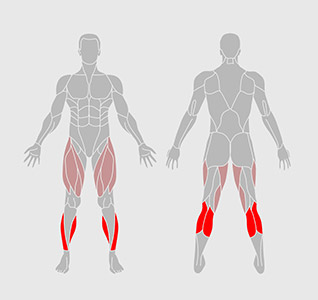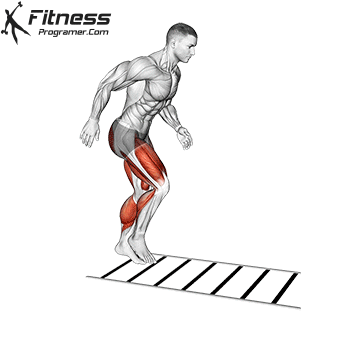Agility ladders work several muscles. They target key areas to boost performance.
Agility ladders are popular in fitness routines. They enhance speed, coordination, and balance. But which muscles do they actually work? Understanding the specific muscle groups targeted can help optimize your workouts. Agility ladders primarily engage the lower body. They activate muscles in the legs, hips, and core.
This makes them a versatile tool for athletes and fitness enthusiasts. Whether you are a beginner or a pro, knowing the muscles involved can improve your training. This blog will explore the key muscle groups worked by agility ladders. Let’s dive in and uncover the secrets behind this effective workout tool.

Credit: darebee.com
Introduction To Agility Ladders
Agility ladders are simple yet effective training tools. They are often used in sports and fitness routines. These ladders lie flat on the ground and have evenly spaced rungs.
Using an agility ladder helps improve foot speed, coordination, and balance. Athletes often use them to enhance their performance. Even beginners can benefit from agility ladder drills.
Benefits Of Agility Ladders
- Improves foot speed: Quick foot movements are essential in many sports.
- Enhances coordination: Coordination between your feet and eyes is crucial.
- Boosts balance: Good balance helps prevent injuries.
- Increases agility: Agility is vital for changing directions quickly.
Importance In Training
Incorporating agility ladders into your routine has many benefits. They help work various muscle groups. Below is a table showing the muscles engaged during agility ladder drills:
| Muscle Group | Function |
|---|---|
| Calves | Supports foot speed and push-off. |
| Quads | Helps with knee extension and stability. |
| Hamstrings | Aids in knee flexion and leg propulsion. |
| Glutes | Provides power for movements. |
| Core | Maintains balance and posture. |
Agility ladders are also great for warming up. They prepare the body for more intense activities. Adding agility drills to your training can improve overall performance.
Primary Muscles Targeted
Agility ladders are a fantastic tool for enhancing your athletic performance. They are known for their ability to improve coordination, speed, and balance. But what muscles do agility ladders work? Let’s break down the primary muscles targeted by agility ladder drills.
Calves And Ankles
Calves and ankles are crucial for quick movements. Agility ladder drills require fast footwork. This puts a lot of stress on your calves. The calf muscles help in pushing off the ground. This allows for quick changes in direction.
The ankle joints also play a significant role. They help in stabilizing your foot during each step. Strong calves and flexible ankles reduce the risk of injuries. They also enhance your overall agility.
Quadriceps And Hamstrings
The quadriceps and hamstrings are essential for explosive movements. These muscles work together to create powerful leg movements. Agility drills often involve jumping or quick directional changes.
Quadriceps help in extending your knees. This action is necessary for pushing off the ground. They also aid in maintaining balance during lateral movements.
Hamstrings are equally important. They help in bending the knees and propelling the body forward. Strong hamstrings reduce the risk of muscle strains and injuries.
Together, the quadriceps and hamstrings enhance your agility. They allow for faster and more efficient movement.
Core Muscle Engagement
Agility ladders are fantastic tools for improving speed and coordination. They are also great for working out your core muscles. The constant movement and quick footwork involved in agility ladder drills force your core muscles to engage and stabilize your body. This not only enhances your balance but also strengthens your core.
Abdominals
Agility ladders require quick foot movements and rapid changes in direction. This constant motion activates your abdominal muscles. They must work hard to keep your body balanced and stable. Each drill you perform with an agility ladder forces your abs to contract and engage. This helps to develop stronger and more defined abdominal muscles. Whether you’re doing side steps, high knees, or in-and-out drills, your abs get a thorough workout.
Lower Back
While the abdominals are working hard, your lower back muscles are also engaged. They help maintain proper posture and alignment during agility drills. A strong lower back is essential for overall core strength. It supports your spine and prevents injuries. The rapid footwork and quick changes in direction strengthen your lower back muscles. This improves your agility and overall athletic performance.
Credit: workoutlabs.com
Upper Body Involvement
Agility ladders are often associated with lower body training. But they also play a significant role in engaging the upper body. This section delves into how agility ladders work the upper body muscles. Let’s explore how your shoulders, arms, and chest benefit from agility ladder drills.
Shoulders
Agility ladder exercises require rapid arm movements. These movements engage the shoulder muscles. The deltoids in your shoulders help maintain balance and coordination. During drills, you constantly adjust your arm positions. This action strengthens your shoulder muscles over time.
Arms And Chest
Quick arm movements during agility ladder drills also work your biceps and triceps. These muscles help drive the rapid arm swings. This enhances your overall speed and agility. Additionally, the pectorals in your chest assist in stabilizing upper body movements. Keeping your chest engaged helps maintain a steady rhythm. This coordination between your arms and chest improves your overall performance.
Enhancing Speed And Strength
Agility ladders are a fantastic tool for enhancing both speed and strength. They target various muscles, helping athletes of all levels improve their performance. In this section, we will explore how agility ladders can enhance speed and strength through specific drills and exercises.
Speed Drills
Agility ladders are excellent for speed drills. These drills focus on quick foot movements. They help in developing fast-twitch muscle fibers. The primary muscles involved include the calves, hamstrings, and quadriceps.
Some effective speed drills include:
- High Knees: Run through the ladder, lifting your knees high.
- Side Steps: Move sideways through the ladder, quickening your steps.
- In and Out: Place both feet inside and then outside each rung.
These drills improve your overall speed and agility. Consistent practice leads to better performance in sports.
Strength Exercises
Agility ladders are not just for speed; they also enhance strength. These exercises focus on muscles that support powerful movements. The main muscles worked include the glutes, core, and hip flexors.
Strength exercises using agility ladders include:
- Lateral Lunges: Step sideways into each rung, focusing on deep lunges.
- Plank Walks: Use your hands to walk through the ladder while in a plank position.
- Single-Leg Hops: Hop through the ladder on one leg, alternating legs.
These exercises build muscle strength and improve balance. They are crucial for athletes aiming for peak physical condition.
In conclusion, agility ladders are versatile tools for enhancing both speed and strength. Including them in your training routine can significantly boost your performance.

Credit: fitnessprogramer.com
Frequently Asked Questions
What Muscles Do Agility Ladders Target?
Agility ladders primarily target the lower body. They engage calves, quadriceps, hamstrings, and glutes.
Do Agility Ladders Work The Core Muscles?
Yes, agility ladders also work the core. They help improve balance and stability by engaging the abs and obliques.
Are Agility Ladders Good For Cardiovascular Health?
Yes, agility ladders boost cardiovascular health. They increase heart rate and improve endurance through quick and repetitive movements.
Can Agility Ladders Improve Coordination?
Yes, agility ladders improve coordination. They enhance footwork, speed, and overall body control through various drills.
How Often Should I Use Agility Ladders?
Use agility ladders 2-3 times a week. This frequency ensures muscle engagement and allows for proper recovery.
Conclusion
Agility ladders target many muscles. They strengthen calves, quads, and hamstrings. Core and hip flexors gain strength too. Regular use improves balance and coordination. These exercises enhance overall fitness. They also boost speed and agility. Perfect for athletes and fitness lovers alike.
Try agility ladders in your routine. See the benefits in no time. Consistency is key. Keep challenging yourself. Enjoy the results!
Recent Posts
Maintaining clean gutters is essential for preventing water damage to your home, and choosing the best ladder for cleaning gutters can make the job much easier and safer. With so many options on the...
Best Ladder for Cleaning Caravan Roof: Top Picks for You Every Adventure!
Today we will discuss the best ladder for cleaning caravan roof. Cleaning caravan roofs is one of the crucial tasks.After many days, a caravan roof can get dirty by debris, dirt, and grime. These can...
